GTM Research’s Solar Summit Mexico, which took place in Mexico City on February 13 and 14, provided a comprehensive insight into the Mexican solar energy landscape.
All participants were in agreement that Mexico is on track to become one of the world’s most interesting solar markets in the coming years. Despite the challenges, which were highlighted during the conference by CEOs, analysts and government officials, the market presents an abundance of opportunities across all segments, chiefly due to its stable regulatory framework, which was created alongside the country’s energy reform three years ago.
The energy reform: A point of no return
Although Mexico’s upcoming presidential elections and possible changes to the North American Free Trade Agreement (NAFTA) were highlighted as points of uncertainty in terms of the future of both the country’s economy and energy market, it was agreed that the energy reform – introduced in December 2013 and which has enabled large amounts of solar and renewable energy capacity deployment, while radically changing the hydrocarbon and electricity sectors – is a point of no return.
The reform was enacted via a series of constitutional amendments, which will require all future governments that want to introduce substantial changes to the reform, to have a large majority and ample consensus.
That the energy reform could be improved, however, was also stressed by several speakers, particularly regarding new provisions for storage, grid capabilities, and more transparent prices for the energy market.
More options for large-scale solar, auctions
The auction mechanism, also established by the Mexican government in 2013, has so far allocated 4.5 GW of solar capacity under the first three rounds.
While it remains unclear how much of the capacity will actually be installed, as opposed to being either delayed or cancelled, the Mexican solar market has, to date, recorded the world’s lowest solar bid in its third auction round. Overall, bidding has been very aggressive, which has served to attract a lot of global attention.
According to Jessica Rodríguez Aguilar, director of renewable energy at Mexico’s Department of Energy, SENER, the fourth bidding round, which will be held this year, will likely allocate more capacity for geothermal and hydropower projects, although this should not affect the development of wind and solar.
“We don’t need to change anything,” added Aguilar, when asked how the current auction mechanism could be improved.
However, auctions may not be the only option for large-scale solar development in the near future, according to Hector Olea, president of Asolmex, the Mexican solar association, who claimed that PV in Mexico is now ready to go merchant.
The main issue for these kind of projects remains the lack of price transparency on the spot market, he added.
“Currently the marginal price in the market is at an average of US$60 per MWh. While in the auctions this same energy is being paid at $20. So, there is a very important area of opportunity, in which new projects can directly participate,” said Olea.
He also stressed, however, the necessity of constantly monitoring the spot market, in order to make more room for solar and renewables. “We need a market that has a track record with confidence in the long term, and with efficient and correct prices. And that is the challenge that we currently have,” he said.
Financing for the spot market, as well as for the auctions, still remains a key issue in the Mexican energy market. More commercial banks and Mexican investors have been called upon to participate, as in the first three auctions, it was mainly development banks and international funds that were involved.
Distributed generation needs clarity on prices
Distributed solar power was one of the main drivers of last year’s growth in Mexico. Several issues, according to the conference’s participants, may hinder or slow down further development, if not fully addressed.
The most urgent issue is represented by the new electricity tariff methodology, which the Mexican government is expected to issue soon. The new methodology is said to be clearly segmented, to show how much consumers will pay for each segment. Until the new prices are set, however, it remains difficult to calculate the risks and potential gains of future projects.
Another measure, which has been called for, is the extension of a simple permit procedure for projects between 500 kW to 2 MW in size under net metering.
This may open the market to a larger number of players, and encourage more Mexican businesses and industries to reduce their energy bills by going solar – something that could result in lower power prices of 15 to 20%.
In this regard, education and creating awareness of the advantages of solar will be the main task for next year, for those who want more distributed generation in the Mexican energy market.
Storage is far from commercial viability, but interest is increasing
Mexico's energy regulatory commission, CRE and the National Energy Control Center, CENACE, have recently started to understand how storage and smart-grids can be integrated in the market, said SENER’s Aguilar.
The lack of a dedicated regulation still remains the main obstacle in understanding how quickly storage technologies and prices can evolve in the country’s renewable energy scenario. Interest from developers and integrators, however, is on the increase, on the back of a maturing energy market, at least in Latin America.
Grid capabilities must be expanded, while creative solutions from the storage sector could be adopted to increase power system reliability, particularly since solar and renewable energy generation capacity will increase as a result of last years’ auctions.

Image: Emiliano Bellini/pv magazine
A key event for all investors and market players
All in all, the Solar Summit Mexico is a must-attend event for all that seek serious solar PV business opportunities in Mexico.
The high profile of the speakers and moderators, as well as the in-depth analysis provided by its participants, are a necessary tool in understanding the numerous challenges present in the Mexican energy market, such as environmental permiting procedures, relationships with local communities, interconnection authorizations, grid reliability, a clear understanding of prices, the development of local partnerships, and good financing conditions.
Mexico is a rapidly growing economy, with an increasing energy demand. This will attract more players in both the short- and long-term, and will inevitably strengthen competition.
Overall, understanding the market mechanisms, together with the Mexican business culture, will be key to making projects more bankable.
This content is protected by copyright and may not be reused. If you want to cooperate with us and would like to reuse some of our content, please contact: editors@pv-magazine.com.




Don’t you think that the cancellation froñ the auction of Februray 2019 will not impact the development of the Mexican PV market??